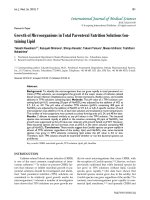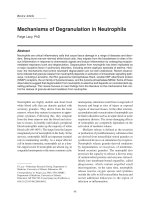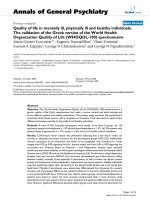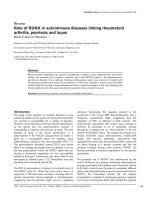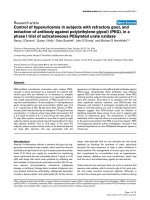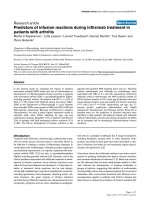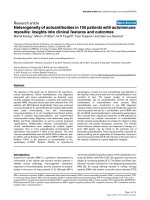Báo cáo y học: "Predictors of outcome in myxoedema coma" doc
Bạn đang xem bản rút gọn của tài liệu. Xem và tải ngay bản đầy đủ của tài liệu tại đây (40.68 KB, 2 trang )
Page 1 of 2
(page number not for citation purposes)
Available online />Abstract
Myxoedema coma is a rare and life-threatening illness the outcome
of which has not been robustly studied in large numbers, partly due
to its low incidence. Dutta and colleagues have explored outcome
predictors in a developing country where access to thyroid
function tests is more limited than in the Western world. Cardio-
vascular instability, reduced consciousness, persistent hypo-
thermia, and sepsis all contributed to a poorer outcome, as has
been demonstrated before, but a generic outcome predictor model
was shown to be useful in this group of patients. Unfortunately, this
observational study was unable to show differences in outcome
based on replacement treatment methods and the mortality
remains at 40%.
Myxoedema coma is a rare endocrine emergency resulting
from decompensation of severe hypothyroidism, as Dutta and
colleagues [1] rightly comment in their recent article. It can
be the presenting feature of hypothyroidism or occur in
previously diagnosed individuals who either have been
partially treated or have been exposed to some form of stress.
Diagnosis is difficult due to the rarity of the condition and its
insidious onset but is suggested clinically by the presence of
altered mental state, dysthermoregulation, and a precipitating
factor such as cold exposure, sepsis, or drugs [2-4].
Biochemically, serum thyroxine (T
4
) and triiodothyronine (T
3
)
concentrations are reduced, with either elevated thyroid-
stimulating hormone (TSH) in primary hypothyroidism or low
or normal TSH in secondary hypothyroidism. One of the
pitfalls in diagnosis is that ‘coma’ is a misnomer as patients
may present only with signs of cognitive deterioration, such
as lethargy, confusion, or disorientation. The other charac-
teristic clinical features of severe hypothyroidism are often
present, including dry skin, sparse hair, a hoarse voice,
periorbital oedema, non-pitting peripheral oedema, macro-
glossia, and delayed deep tendon reflexes. Biochemically,
anaemia, hyponatraemia, hypoglycaemia, hypercholesterol-
aemia, and high serum lactate dehydrogenase and creatine
kinase concentrations may be evident [5].
Due to the rarity of myxoedema coma, very few randomised
controlled trials have been undertaken to look at the
treatment and outcome; however, myxoedema coma remains
an important entity to diagnose. The prevalence of hypo-
thyroidism is likely to increase with advancements in diag-
nostic tools and the increased practice of offering definitive
treatment for hyperthyroidism in the form of radioactive iodine
treatment and thyroidectomy. Clinicians need to have a high
index of clinical suspicion to make an early diagnosis when
myxoedema coma is present. Mortality has fallen from 80% to
20%-40% in treated individuals partly due to increased
awareness of physicians, improved diagnostic testing, and
advances in intensive care [3]. However, these statistics are
based on developed countries and Dutta and colleagues
raise a pertinent point in highlighting the differences in the
developing world, where ready access to laboratory tests is
not always possible and education for the primary physician,
who does not have to deal with large numbers of thyroid
conditions, remains important.
It is evident that these patients need to be treated in an
intensive care setting with close monitoring of their cardio-
vascular status. Ventilatory support is often needed because
of decreased level of consciousness, respiratory depression
secondary to drugs, underlying pneumonia, or sometimes
macroglossia or myxoedema of the larynx resulting in airway
obstruction [3]. Hypothermia, besides conventional treatment
with warm blankets and fluids, requires replacement with
thyroid hormones to normalise thermoregulation. There is
consensus that all patients should be given glucocorticoids
as these patients may have coexistent adrenal insufficiency;
thyroid hormone replacement may result in increased
metabolism of cortisol, thereby precipitating adrenal crisis.
However, controversy regarding optimal replacement regi-
mens persists due to the paucity of large clinical trials [6-10].
Three different regimens have been advocated: (a) intra-
venous (IV) or oral T
4
, (b) IV T
3
, or (c) a combination of T
4
and
Commentary
Predictors of outcome in myxoedema coma
Jennifer Beynon, Simeen Akhtar and Tara Kearney
Endocrinology Department, Salford Royal NHS Foundation Trust, Stott Lane, Salford, M6 8HD, UK
Corresponding author: Jennifer Beynon,
Published: 23 January 2008 Critical Care 2008, 12:111 (doi:10.1186/cc6218)
This article is online at />© 2008 BioMed Central Ltd
See related research by Dutta et al, />IV = intravenous; T
3
= triiodothyronine; T
4
= thyroxine; TSH = thyroid-stimulating hormone.
Page 2 of 2
(page number not for citation purposes)
Critical Care Vol 12 No 1 Beynon et al.
T
3
. Unfortunately, the work of Dutta and colleagues has not
moved the debate forward with a definite answer; no clinical
or biochemical differences were observed between those
patients who initially received IV compared with oral T
4
. Arlot
and colleagues [6] demonstrated that although oral absorp-
tion of levothyroxine was variable, the clinical response
occurred promptly, even in a case of myxoedema ileus. A
prospective study by Rodríguez and colleagues [7] found that
the administration of higher doses of levothyroxine appeared
to reduced mortality, although statistical significance was not
reached. All studies are limited by small sample size.
Predictors of poor outcome in patients with myxoedema
coma include increased age, cardiovascular compromise, and
reduced consciousness. In the study by Rodríguez and
colleagues [7], mortality rates for both primary and secondary
hypothyroidism were similar and survival was independent of
the mean free T
4
and TSH concentrations. The analysis of
Dutta and colleagues of de novo subjects compared with
treatment defaulters is interesting epidemiologically and again
highlights the importance of education. Nevertheless, this
information is not useful in determining the outcome once the
patients have reached the intensive care setting, unlike the
SOFA (Sepsis-related Organ Failure Assessment) score,
which provides a more dynamic approach in predicting out-
come by regularly analysing six systems, namely respiration,
cardiovascular, liver, coagulation, renal, and neurological [11].
Competing interests
The authors declare that they have no competing interests.
References
1. Dutta P, Bhansali A, Masoodi S, Bhadada S, Sharma N, Rajput R:
Predictors of outcome in myxoedema coma: a study from a
tertiary care centre. Crit Care 2008, 12:R1.
2. Nicoloff JT: Thyroid storm and myxedema coma. Med Clin
North Am 1985, 69:1005-1017.
3. Wartofsky L: Myxedema coma. Endocrinol Metab Clin North Am
2006, 35:687-698.
4. Fliers E, Wiersinga WM: Myxedema coma. Rev Endocr Metab
Disord 2003, 4:137-141.
5. Benvenga S, Squadrito S, Saporito F, Cimino A, Arrigo F, Tri-
marchi F: Myxedema coma of both primary and secondary
origin, with non-classic presentation and extremely elevated
creatine kinase. Horm Metab Res 2000, 32:364-366.
6. Arlot S, Debussche X, Lalau JD, Mesmacque A, Tolani M,
Quichaud J, Fournier A: Myxoedema coma: response of thyroid
hormones with oral and intravenous high–dose L-thyroxine
treatment. Intensive Care Med 1991, 17:16-18.
7. Rodríguez I, Fluiters E, Pérez-Méndez LF, Luna R, Páramo C,
García-Mayor RV: Factors associated with mortality of patients
with myxoedema coma: prospective study in 11 cases treated
in a single institution. J Endocrinol 2004, 180:347-350.
8. Hylander B, Rosenqvist U: Treatment of myxoedema coma—
factors associated with fatal outcome. Acta Endocrinol
(Copenh) 1985, 108:65-71.
9. Yamamoto T, Fukuyama J, Fujiyoshi A: Factors associated with
mortality of myxedema coma: report of eight cases and litera-
ture survey. Thyroid 1999, 9:1167-1174.
10. Pereira VG, Haron ES, Lima-Neto N, Medeiros-Neto GA: Man-
agement of myxedema coma: report on three successfully
treated cases with nasogastric or intravenous administration
of triiodothyronine. J Endocrinol Invest 1982, 5:331-334.
11. Vincent JL, Moreno R, Takala J, Willatts S, De Mendonça A, Bruin-
ing H, Reinhart CK, Suter PM, Thijs LG: The SOFA (Sepsis-
related Organ Failure Assessment) score to describe organ
dysfunction/failure. On behalf of the Working Group on
Sepsis-Related Problems of the European Society of Inten-
sive Care Medicine. Intensive Care Med 1996, 22:707-710.


